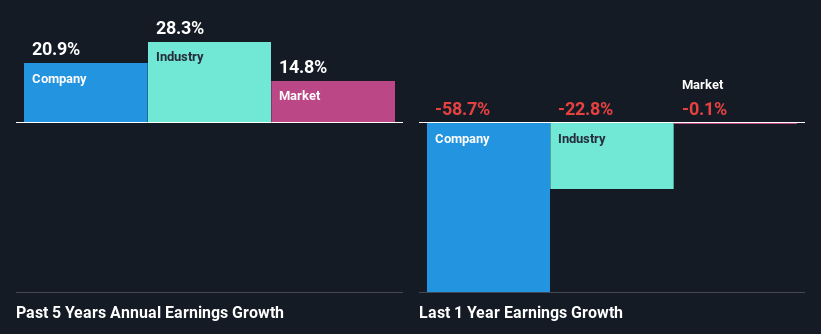Are SEEK Limited's (ASX:SEK) Mixed Financials The Reason For Its Gloomy Performance on The Stock Market?
It is hard to get excited after looking at SEEK's (ASX:SEK) recent performance, when its stock has declined 4.6% over the past three months. It is possible that the markets have ignored the company's differing financials and decided to lean-in to the negative sentiment. Long-term fundamentals are usually what drive market outcomes, so it's worth paying close attention. Specifically, we decided to study SEEK's ROE in this article.
Return on equity or ROE is a key measure used to assess how efficiently a company's management is utilizing the company's capital. In short, ROE shows the profit each dollar generates with respect to its shareholder investments.
View our latest analysis for SEEK
How To Calculate Return On Equity?
Return on equity can be calculated by using the formula:
Return on Equity = Net Profit (from continuing operations) ÷ Shareholders' Equity
So, based on the above formula, the ROE for SEEK is:
4.0% = AU$103m ÷ AU$2.6b (Based on the trailing twelve months to December 2023).
The 'return' is the amount earned after tax over the last twelve months. One way to conceptualize this is that for each A$1 of shareholders' capital it has, the company made A$0.04 in profit.
What Is The Relationship Between ROE And Earnings Growth?
Thus far, we have learned that ROE measures how efficiently a company is generating its profits. We now need to evaluate how much profit the company reinvests or "retains" for future growth which then gives us an idea about the growth potential of the company. Assuming everything else remains unchanged, the higher the ROE and profit retention, the higher the growth rate of a company compared to companies that don't necessarily bear these characteristics.
SEEK's Earnings Growth And 4.0% ROE
It is hard to argue that SEEK's ROE is much good in and of itself. Even when compared to the industry average of 8.1%, the ROE figure is pretty disappointing. However, we we're pleasantly surprised to see that SEEK grew its net income at a significant rate of 21% in the last five years. We reckon that there could be other factors at play here. For example, it is possible that the company's management has made some good strategic decisions, or that the company has a low payout ratio.
We then compared SEEK's net income growth with the industry and found that the company's growth figure is lower than the average industry growth rate of 28% in the same 5-year period, which is a bit concerning.
The basis for attaching value to a company is, to a great extent, tied to its earnings growth. What investors need to determine next is if the expected earnings growth, or the lack of it, is already built into the share price. This then helps them determine if the stock is placed for a bright or bleak future. Is SEEK fairly valued compared to other companies? These 3 valuation measures might help you decide.
Is SEEK Making Efficient Use Of Its Profits?
The high three-year median payout ratio of 75% (implying that it keeps only 25% of profits) for SEEK suggests that the company's growth wasn't really hampered despite it returning most of the earnings to its shareholders.
Moreover, SEEK is determined to keep sharing its profits with shareholders which we infer from its long history of paying a dividend for at least ten years. Based on the latest analysts' estimates, we found that the company's future payout ratio over the next three years is expected to hold steady at 73%. Still, forecasts suggest that SEEK's future ROE will rise to 13% even though the the company's payout ratio is not expected to change by much.
Conclusion
On the whole, we feel that the performance shown by SEEK can be open to many interpretations. While no doubt its earnings growth is pretty respectable, the low profit retention could mean that the company's earnings growth could have been higher, had it been paying reinvesting a higher portion of its profits. An improvement in its ROE could also help future earnings growth. With that said, the latest industry analyst forecasts reveal that the company's earnings are expected to accelerate. To know more about the company's future earnings growth forecasts take a look at this free report on analyst forecasts for the company to find out more.
Have feedback on this article? Concerned about the content? Get in touch with us directly. Alternatively, email editorial-team (at) simplywallst.com.
This article by Simply Wall St is general in nature. We provide commentary based on historical data and analyst forecasts only using an unbiased methodology and our articles are not intended to be financial advice. It does not constitute a recommendation to buy or sell any stock, and does not take account of your objectives, or your financial situation. We aim to bring you long-term focused analysis driven by fundamental data. Note that our analysis may not factor in the latest price-sensitive company announcements or qualitative material. Simply Wall St has no position in any stocks mentioned.

 Yahoo Finance
Yahoo Finance 
